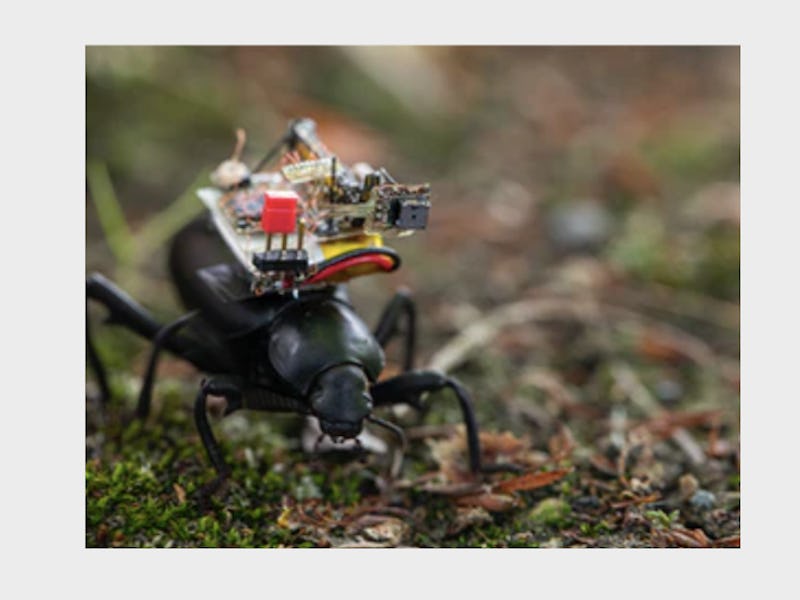Super small cameras will create insect spies for farmers
Honey, I shrunk the bug cameras.

Ever wondered what it's like to literally be a fly on the wall? A new, super small camera designed to be worn on the back of bugs like a backpack could finally be your chance to experience the real Bug's Life. And these tiny computerized critters could play a vital role in keeping your breakfast safe.
What's the news -- In a new study published Wednesday in the journal Science Robotics, a team of engineers from the University of Washington describes how they designed a very tiny, light-weight camera that could be attached to an insect to wirelessly stream back POV video to a nearby smartphone. Vikram Iyer, the study's first author and Ph.D. student in Electrical and Computer Engineering at the University of Washington, tells Inverse that shrinking down this camera was a question optimizing of weight, size and power output.
"Vision is very important for us, as well as any other animal, and it's something you see commonly on larger robotic systems like autonomous cars. But when you try to shrink it down to the size of a penny it becomes very challenging," says Iyer. "You have to consider a number of different factors, including the size, the weight, and the power consumption. These are all different things we had to optimize."
Shrinking computer vision down to this size could have major implications for medical robotics as well as behavioral studies on insects, Iyer tells Inverse.
At only 250 milligrams, the entire camera system weighs less than one-tenth of a playing card.
How does it work -- Cameras in our smartphones have become incredibly small and high-def, but for Iyer and the team, this approach simply required too much power and weight to be feasible for their tiny insects. Instead, the study's senior author, Shyam Gollakota, tells Inverse that a major innovation in this research was to mimic a key feature of insect vision: how they move their heads.
"If I'm looking at a moving bird, I'm not moving my whole body to track the moving bird," says Gollakota. "I'm just looking at a particular bird. It turns out that this is actually a very important optimization method because it's extremely power efficient."
This feature, combined with an accelerometer that powered off the camera when the insect wasn't moving, helped the team design a nearly 1/550th of a pound (84-milligram) wireless camera that could receive steering commands via Bluetooth from nearly 400 feet away and operate for six continuous hours. At 250 milligrams, the whole system weighed less than one-tenth of a playing card.
These beetles were equipped with tiny camera backpacks and sent gallivanting around a local parking lot.
In addition to designing a camera to mount on the back of an insect, like the darkling beetle, the team also designed a tiny robot to carry the camera as well. Mimicking the insect's active vision to swivel the camera's "eye" 60 degrees meant that the robot could save power by not moving its entire body.
What were the results -- To test how an insect would react to the extra weight of this tiny camera, the researchers suited up a selection of insects with camera backpacks and set them free in a Washington parking lot.
During their galavanting around the parking lot, the team observed the insects climbing rough terrain, like rocks, without any difficulty, suggesting that the weight and balance of the camera did not affect their daily activities. As for streaming, the team was able to use a smartphone to send signals to the camera to steer its "eye" and received black and white footage from the beetle's POV at 1 to 5 frames per second. For comparison, movies and TV are typically shown at 24 frames per second.
One small step for a bug, is one big innovation for a super, small camera.
What's next -- The authors write in the study that the innovations they've made in designing this light-weight, steerable camera could be used in a number of different ways, from endoscopy robots to farmers equipping bugs with tiny cameras to keep an eye on their crops. In the future, Iyer tells Inverse that the team plans to expand the control they have over these cameras, including collecting other behavioral information from the insects such as neural activity.
Abstract: Vision serves as an essential sensory input for insects but consumes substantial energy resources. The cost to support sensitive photoreceptors has led many insects to develop high visual acuity in only small retinal regions and evolve to move their visual systems independent of their bodies through head motion. By understanding the trade-offs made by insect vision systems in nature, we can design better vision systems for insect-scale robotics in a way that balances energy, computation, and mass. Here, we report a fully wireless, power-autonomous, mechanically steerable vision system that imitates head motion in a form factor small enough to mount on the back of a live beetle or a similarly sized terrestrial robot. Our electronics and actuator weigh 248 milligrams and can steer the camera over 60° based on commands from a smartphone. The camera streams “first person” 160 pixels–by–120 pixels monochrome video at 1 to 5 frames per second (fps) to a Bluetooth radio from up to 120 meters away. We mounted this vision system on two species of freely walking live beetles, demonstrating that triggering image capture using an onboard accelerometer achieves operational times of up to 6 hours with a 10–milliamp hour battery. We also built a small, terrestrial robot (1.6 centimeters by 2 centimeters) that can move at up to 3.5 centimeters per second, support vision, and operate for 63 to 260 minutes. Our results demonstrate that steerable vision can enable object tracking and wide-angle views for 26 to 84 times lower energy than moving the whole robot.